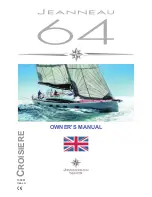
The first hours of the boat operation have critical requirements for engine break-
in. This information is contained in the engine owner’s manual. Be sure to review this
information carefully. Failure to follow the instructions will void the engine warranty!
With regard to the boat, pay close attention to the gauges, and monitor the
readings. Pay particular attention to the oil pressure and engine temperature
information as these are the earliest warnings if something is going wrong with
the drive train. Alarms will sound if serious problems are encountered.
Also, check carefully for leaks. The break-in period is the most-likely time for
leaks to appear, whether fuel, oil, water or exhaust.
Newcomers to boating, especially to the size of the Axis models, are strongly
encouraged to take a U.S. Coast Guard boating class before using the boat.
Reading about boating conditions and operations from websites such as the
National Marine Manufacturers Association (NMMA) and the many yachting
association sites can be very helpful.
Practice, practice, practice!
Begin in optimum weather and water conditions,
avoiding tight quarters until you are comfortable. The boat actually steers
more easily when the boat is on-plane. This is achieved by speeding up briskly
from idle. By throttling and increasing the speed, the boat will ride up higher on
the body of water. With less friction between boat hull and water, the boat will
maneuver more easily. At slower speeds, the boat is less responsive, so practice
is important to achieve the kind of maneuverability that is desirable.
Remember that steering in a boat is from the rear (stern). The unseen
rudder operates from the steering wheel, but the actual steering through the rudder is different
from a car. Note that stern control means that the boat will push away from the direction of the
turn. The bow will follow a smaller turning circle than the stern does.
Note that the propeller does not move the boat directly forward. Due to the rotation
(generally, counterclockwise), the boat’s natural progress will have a slight port tracking (when
in forward gear) and to starboard when in reverse. At slower speeds, this phenomenon is more
pronounced. Depending also on the body of water depth and width, it may be necessary for the
operator to compensate for this natural movement.
The lack of brakes requires the operator to think more quickly and react
accordingly to avoid damaging contact with other boats, docks and the shore.
When stopping the boat, it is acceptable to use reverse gear (much as airplanes
use reverse thrust). This is a technique that takes time and practice to master.
Slamming from forward to reverse gear can damage the system. Allow sufficient
time to move the shifter from forward to neutral, briefly pausing, and then ease
into reverse. Always slow to a no-wake speed before attempting these shifts
and do not shift into reverse if the boat is moving faster than 2 mph (3.2 km/h).
Do not disconnect the emergency safety switch as
a method to stop the boat. Doing so impairs the
ability to restart the engine quickly or it may create a
hazardous swamping condition.
Axis
Owners
Manual
2019
Page 137
break-in
period
smart
operations
stopping
Summary of Contents for A20
Page 1: ......
Page 4: ......
Page 10: ......
Page 11: ...safety ...
Page 12: ......
Page 55: ......
Page 57: ...quick reference guide ...
Page 58: ......
Page 71: ......
Page 72: ...dashes and video screens ...
Page 91: ......
Page 92: ...how it works ...
Page 123: ......
Page 124: ...trailers ...
Page 142: ...Axis Owners Manual 2019 Page 131 ...
Page 143: ......
Page 144: ...get ready ...
Page 152: ...Axis Owners Manual 2019 Page 141 ...
Page 153: ......
Page 154: ...care and maintenance ...
Page 180: ...Axis Owners Manual 2019 Page 169 ...
Page 181: ...limited warranty ...
Page 182: ......
Page 204: ...Date Date Date Date Date Date Date Date ...
Page 213: ......
Page 214: ......
















































